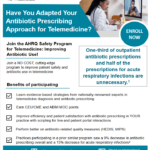Educational Resources
Updates
-

AHRQ Safety Program for Telemedicine: Improving Antibiotic Use
Is your practice interested in improving appropriate use of antibiotics in telemedicine? The Agency for Healthcare Research and Quality (AHRQ) is currently recruiting practices for a no-cost, 18-month program beginning in June 2024 to promote appropriate antibiotic use while maintaining patient satisfaction and reducing potential side effects in patients seen via telemedicine. Practices will receive … Read more
-

Through April 10: Super Steward Nominations Open
Take 3 minutes to nominate yourself or a colleague. “CASP created these awards to recognize colleagues’ efforts to support the appropriate and effective use of antimicrobials,” said Nikolaos Mavrogiorgos, MD, CASP medical director. “Each of us can make meaningful changes that improve improve patient care and fight antimicrobial resistance. We value those contributions and want … Read more
Stewardship Educational Resources
- Antibiotic Use in the United States: 2023 Update from the Centers for Disease Control and Prevention
- Antimicrobial Stewardship information and tools available from the Society for Healthcare Epidemiology of America (SHEA)
- Compendium of Strategies to Prevent Healthcare-associated Infections in Acute Care Hospitals: 2023 update from SHEA
- Resources on antimicrobial stewardship and resistance from the Infectious Diseases Society of America
The US Centers for Disease Control and Prevention and the Agency for Healthcare Quality and Research are two of several agencies of the U.S. Department of Health and Human Services charged with leading national efforts on antimicrobial use and resistance. Their websites provide a wealth of resources and information, including:
- COVID-19: US Impact on Antimicrobial Resistance – A June 2022 report on the COVID-19 pandemic’s negative effect on antibiotic resistance
- Core Elements for Hospital Antimicrobial Stewardship Programs (2019) define structural and procedural components that are associated with successful stewardship programs. The site also includes resources tailored for small & critical access facilities , outpatient settings, nursing homes, and resource-limited facilities.
- The National Quality Forum‘s Antimicrobial Stewardship Playbook (2016, free download) provides real-world ideas for application of the CDC’s Core Elements of Antibiotic Stewardship.
- Antibiotic Resistance Threats in the United States, 2019 includes the latest national death and infection estimates that underscore the continued threat of antibiotic resistance in the U.S.
- CDC’s Antibiotic Stewardship Training Series (free with account creation; C.E. available) is a nine-module, interactive, web-based training designed to help clinicians optimize antibiotic use to combat antibiotic resistance and improve healthcare quality and patient safety.
- Agency for Healthcare Research and Quality’s Safety Program for Improving Antibiotic Use, now completed, supported clinicians apply the Comprehensive Unit-based Safety Program (CUSP) method to improve antibiotic stewardship by selecting the optimal antibiotic regimens, routes of administration, and durations.
- The AHRQ developed an Antibiotic Stewardship Toolkit for acute care hospitals (2019), with additional toolkits in development for long-term care and ambulatory care practices (2022).
- Antibiotic Resistance & Patient Safety Portal (formerly the Patient Safety Portal) allows users to explore and visual data on antibiotic resistance and healthcare-associated infections
- CDC’s National Healthcare Safety Network (NHSN) publishes reports from its data on topics such as antimicrobial use and resistance, including antimicrobial-resistance pathogens associated with healthcare-associated infections
- Healthcare-associated Infections Data Dashboards: UNC Hospitals’ Department of Infection Prevention collects and analyzes healthcare-associated infection data and process measures for compliance with evidence-based infection prevention practices. The interactive Tableau dashboards are updated monthly and allow customizable search features.